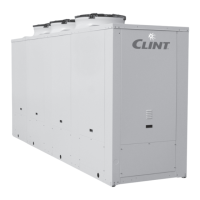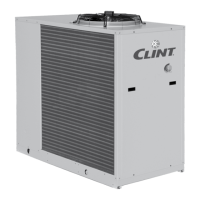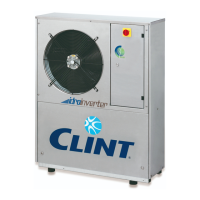20
CHA
6 avviamento
6.1
CONTROLLI PRELIMINARI ALL’AVVIAMENTO
- Verificare che i collegamenti elettrici siano stati eseguiti
correttamente e che siano stati serrati tutti i morsetti.
- Verificare il serraggio a fondo dei tappi portafusibile
- Verificare che la tensione sui morsetti L
1
, L
2
, L
3
, sia quella
riportata sulla targa dell’unità (tolleranza ammessa)
±5% controllabile con un tester. Se avvengono frequenti
variazioni di tensione, si prega di contattare il nostro
ufficio tecnico per la scelta di opportune protezioni.
- Verificare che i manometri (quando presenti) indichino
una adeguata pressione. I manometri possono essere
muniti di rubinetti di intercettazione. Essi vanno aperti
solo quando necessario, una volta effettuati i rilievi
devono essere chiusi nuovamente
- Controllare, eventualmente tramite l’ausilio di un cerca-
fughe, che non vi siano perdite di fluido refrigerante.
- Verificare che le resistenze del carter (se presenti)
siano correttamente alimentate.
L’inserimento delle resistenze deve essere
fatto almeno 12 ore prima dell’avviamento,
ed avviene automaticamente alla chiusura
del sezionatore generale (posizione I).
Per controllare se le resistenze funzionano correttamente,
verificare che la parte inferiore del compressore sia ad una
temperatura di 10÷15°C superiore a quella ambiente.
- Verificare il corretto collegamento del circuito idraulico
(devono essere rispettate le indicazioni sulle targhette
a bordo macchina).
- Assicurarsi che il circuito idraulico sia stato preventi-
vamente pulito: si consiglia di effettuare un lavaggio
del circuito idraulico by passando l’unità e quindi
verificare lo stato di pulizia del filtro dell’impianto.
- Le macchine vengono spedite con sfiati e drenaggi
aperti. Apposite targhette indicano le loro posizioni.
Essi vanno chiusi all’atto dell’installazione quando si
riempie il circuito idraulico.
- Nei modelli provvisti di gruppo idronico, il tappo di scarico
acqua della pompa è stato tolto, al fine di scaricare l'acqua
in essa contenuta ed evitare problemi di gelo durante la
stagione invernale. Il tappo è stato collocato all'interno
della busta contenente la documentazione dell'unità.
- Verificare che l’impianto idraulico sia stato sfiatato, eli-
minando ogni eventuale residuo d’aria, l’operazione va
eseguita caricando gradualmente e aprendo i dispositivi
di sfiato disposti dall’installatore nella parte superiore del-
l’impianto (a tale proposito consultare la sezione 5.2).
- Qualora si utilizzi acqua glicolata si può spostare il set
point antigelo, il valore deve essere pari al valore della
temperaturadicongelamentodelfluidopiù6K.»
-
Prima di avviare la pompa è necessario controllare che le
parti in movimento ruotino liberamente. A tale scopo togliere
il copriventola (3) dalla sede del coperchio posteriore del
6 StaRt UP
6.1 PRELIMINARY CONTROLS
- Make sure that the electrical connections have been
made correctly and that all the terminals have been
well tightened.
- Verify the deep closing of the fuses-holder cover
- Use a tester to make sure that the voltage on terminals
L
1
, L
2
, L
3
, is equal to that shown on the rating plate
(permitted tolerance ±5%). If voltage is subject to
frequent variations, please contact our technical office
in order to decide on suitable protection devices.
- Make sure that the pressure gauges (when fitted) show
the correct pressure. The pressure gauges can be fit-
ted with shut-off valves. These must only be opened
when necessary and closed again after inspection.
- Use a leak tester, if necessary to make sure there are
no leaks of refrigerant liquid.
- Check that the heating elements of the sump (if fitted)
are correctly powered.
The heating elements must be turned on
at least 12 hours before start up; this takes
place automatically when the main power
switch is closed (position I).
To check if the heating elements work correctly, make
sure that the lower part of the compressor is 10÷15°C
higher than room temperature.
- Check the water circuit is correctly connected (the indi-
cations on the unit rating plate must be observed).
- Make sure that the water circuit has been cleaned be-
forehand: the water circuit should be washed, bypassing
the unit, and then the system filter checked for dirt.
- The units are despatched with the relief valves and
drains open. Special plates show where they are lo-
cated. They must be closed during installation before
the water circuit is filled.
- In the models with built-in hydraulic kit, the pump water
drain plug has been removed for discarge of the water
therein and to prevent freezing during winter season.
The plug is included into the envelope containing the
documentation of the unit.
- Make sure the water circuit has been well vented to
eliminate any air residues; this operation is carried
out by gradually loading and opening the relief valves
fitted to the uppermost part of the unit by the installer
(please consult section 5.2 for further information).
- In case water with glycol is used, the anti-freezing set
point can be moved, the value must be equal to the value
ofthefreezingtemperatureofthefluidplus6K.»
- Before starting the pump, make sure that the moving
parts turn freely. To do so, remove the fan cover (3)
from the rear motor cover (1), insert a screwdriver into
the notch on the ventilation side of the motor shaft
